![]()
~GΙVxA©]Τcfc[Oρ@English@![]()
@
@
@
-------------------------------------------------------------------------------------------------------------------------------------
Winter Bicycle Touring across Far East Siberia, 2005 Winter
A Journey to the edge of
the
Eurasian continent
----------------------------------------------------------------------------------------------------------------------------------------
Hiromasa Andow
Japan Adventure Cyclist Club

@
Cyclist completes epic trek in Siberian cold.
It took six months, but a 35-year-old Japanese cyclist has completed an 8,600-km
route from Sakhalin to the Chukot Peninsula in Russia's east via Siberia.
Hiromasa Andow arrived in Egvekinot on the peninsula along the Bering Sea in
mid-May 2005 after departing from the southern tip of Sakhalin Island in late
December 2004. He cycled northward on Sakhalin, crossed the frozen Mamiya Strait
in mid-January to the continent and passed Oymyakon in eastern Siberia, which is
dubbed "the pole of cold." He arrived at the Arctic Ocean coast in mid-April and
turned east toward his destination. Andow said he measured temperatures as low
as minus 52 degrees Celsius but did not feel cold as he was outfitted with
special equipment for cold weather conditions.
Andow, a former member of a Tottori University Alpine Club of Japan, became in
May 2003 the first Japanese to pedal across Siberia in an eight-month solo trip
through the depth of winter. In February 2004, he received an award named after
the late adventurer Naomi Uemura for the 2003 journey.
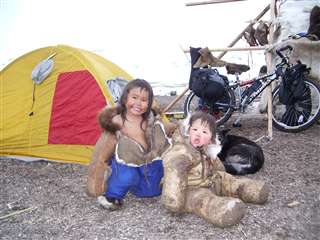 @
@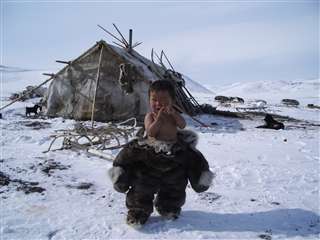 @
@
Reindeer Nomad in Chukot Peninsula
@
---------------------------------------------------------------------------------------------------------------
---------------------------------------------------------------------------------------------------------------
@
Introduction
In May of 2003, I completed my
journey across Siberia -- a nine-month solo trip
with 15,000 -km that took me through the severest period of winter. I began this
trip in Sept. 2002 from Murmansk, the western Russian city in the Arctic region.
I headed east with 15-kilograms of baggage on my bicycle, camping out along the
way. I crossed frozen Lake Baikal and ran on the winter road of Lena River with
studded tires. Finally I arrived at Magadan on the Sea of Okhotsk. However, I
could imagine the unknown world was still continued to the eastern end of
Eurasia.
Time has passed. I started a new challenge to settle my destined travel in the
end of December 2004.
@
Beyond the northernmost edge of Japan
@
Cape Soya is the northernmost edge of Japan in Hokkaido Island. A lot of
Japanese cyclists aim at this cape from all over Japan. Even if we refer a world
map, many cyclists from various countries has already done biking to the end of
the continent where road is finished. For example, the Cape of Good Hope at the
southernmost tip of Africa, Cape Horn at the southernmost end of South America,
Nordkapp at the northernmost point of the European mainland and Cape Roca in
Portugal at the westernmost extremity of Eurasia, so on.
As a mountaineer who aims for a summit of vertical finish, a cyclist who is
horizontal adventurer aims at a cape which is the point of a mainland. However,
there is no precedent for my next bike journey. It is the Eurasian easternmost
end, Cape Dezhnev on the Bering Strait. This is the last challenge in the
Eurasian Continent for cyclists.
Siberia is a vast territory. The Far Eastern region is the severest area in
Siberia. It is permafrost layer and inhospitable snowbound vastness. The
temperature will drop under minus 60 degrees Celsius. There is no road leading
to the Bering Strait. Normally, only airplane is available to visit this area.
However, there is a possibility for cyclist to go there in winter. It becomes
wetland in the permafrost layer in summer. But the road comes into existence in
winter on frozen river and marsh. This winter road is not recorded on map. Only
the local drivers know the fact of this mysterious route. My bicycle challenge
needs this winter road. It is the reason why I have to go to the coldest area in
the coldest season.
We can see Sakhalin Island of Russian territory from Cape Soya on a fine day.
This is ideal starting point for my new challenge. I crossed from Hokkaido to
Sakhalin by ship in the mid-December 2004. Then I headed northward with my bike
towards snow country.
@
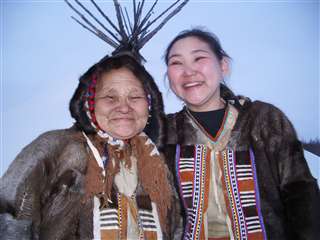 @Evenki
at Kolyma River
@Evenki
at Kolyma River
@
The Mamiya Strait
@
Before World War II, the south part of Sakhalin was Japanese territory. Japanese
racial people still live there, and they welcomed me. I pedaled about 1,000-km
northward from south tip of Sakhalin. There is a point where the width of the
island and the continent decreases quickly. This is the Mamiya strait. A Samurai
Mamiya Rinzou discovered this strait by the explorer 200 years ago. He proved
that Sakhalin is an island not a part of continent.
The straits will be frozen in winter. I can run on the sea to the other side of
the strait by bicycle, where the Eurasia continent stands! It is very
comfortable to run over snow field freely. The narrowest point of the strait has
a quick ocean current, so some places were not frozen. Suddenly the ice was
broken and I fell into the seawater. Although temperature was less than minus 20
degrees Celsius, seawater was about zero degree. So I unexpectedly felt warm in
the seawater. However, my clothes began to freeze immediately after I crept up
from the water. I set up a tent on ice in a hurry. I could revive myself when I
turned on the gasoline stove in the tent and changed into dry clothes.
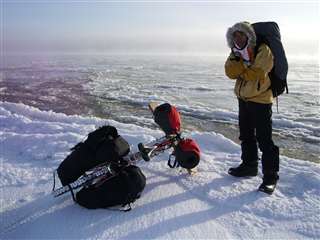 @Across the
Mamiya Strait
@Across the
Mamiya Strait
The Poles of Cold
@
I arrived at Oymyakon of Sakha Republic in late February. This village is famous
for the world record of the coldest temperature minus 71.2 degrees Celsius,
reportedly the lowest ever for any human settlement. It is called the Poles of
Cold. I camped out along the way. One day, the thermometer measured temperatures
as low as minus 52 degrees Celsius. My exhaled air froze immediately, and began
to shine brilliantly. Even winter climbing equipments do not work properly.
The temperature will be at minus 50 degrees Celsius, and this is not unusual
here. I had to prepare even for minus 60 degrees Celsius. It was essential to
prepare special original equipment before I leave for the frigid expedition.
While pedaling on a bike, I am not so cold because I am generating heat myself.
However, the problem is how to survive at chilly night. My sleeping-bag and
clothes will be frozen with my perspiration. There is a long distance between
villages, hundreds of kilometers away. It is difficult to dry up the frozen
equipment in the chilly field.
In cooperation with some Japanese outdoor equipment manufacturers, we developed
special equipments with Vapor Barrier Liner system to survive at extremely
chilly condition. For example, a balloon-like sleeping bag, an airtight tent, a
boots system, a mitten system and so on. I did not feel so cold because I was
outfitted with those splendid equipments.
@
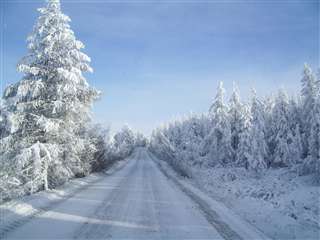 @the pole
of cold
@the pole
of cold
The Winter Roads
It became minus 40 degrees Celsius when March comes, and it gets warmer. Small
wheel ruts of trucks lies on the snow field. It is the beginning of mysterious
winter road toward the Arctic Ocean. The winter road passed thorough over
beautiful frozen lakes and several snowy passes. I found majestic mountain
ranges, breathtaking sceneries, and virgin forests of deep taiga. Then I got to
Kolyma River. The river was frozen, and there was also a winter road on it. The
traffic became less and less. I saw trucks only two or three times per day.
Those trucks were carrying coals, construction materials and foods during winter
because there is no road in summer.
Almost all trucks stopped for me, and they gave me foods. Ethnic minorities live
on the riverside. They make a hole in the ice and fish a river. They also gave
me fish. It is essential for an adventurer or an explorer to eat anything that
can be obtained there. Ability to adapt to a new environment is important for
us. Physical strength comes next. So that means I should be able to sleep
anywhere, readily make friends with anybody and everybody, and eat anything that
people offered. It was a hard adventure travel under a severe nature. However I
was welcomed by every single person that I met.
@
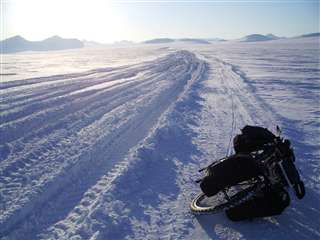 @Winter Road on Tundra
@Winter Road on Tundra
A Nomad
I entered the Arctic Circle. Getting to the Arctic Ocean, the landscape changed
from Taiga forests to Tundra without any trees, not even one. The snowy field
goes on forever. It seems that this wild landscape is as if the planet of ice
dessert in science fiction movies. The more winter road condition got worse, the
more bike speed got slower. When a blizzard arises, the winter road will be
buried under the snow. I had to walk with pushing or carrying bike on my
shoulder.
The wide expanses of tundra were covered with snow and ice. It seems that no
creature living there. However, a human being lives stoutly in this wild
landscape. Several tents came into my view on the hill. There are hundreds of
reindeers near the tents. When I arrived at the camp place, native Chukchi
people welcomed me. They are nomads and still using reindeer sleds. Their life
is very simple. Only a little bit of firewood are available in tundra. They can
use it only for cooking. However, the tent of the reindeerskin has double
layered so when many people are inside, it is warm enough without fire. I
realized what is really necessary for human to live. The essence of ecology
comes into my view.
@
 @
@ @
@
Reindeer Nomad in Chukot Peninsula
@
The Bering Sea
@
It's turning into the midnight sun in May. Spring comes slowly in Siberia,
especially slow in Chukot peninsula. Even so, the winter road is available until
the middle of May. With the approach of warmer weather, the river ice starts to
melt. There is no bridge. I tried to go across the frozen river very carefully,
but sometime I broke through the thin ice.
Finally I could arrive at ocean by crossing over the mountains. It was the
Bering Sea. There is a town Egvekinot at the end of the winter road. Remained
distance to Cape Dezhnev, the easternmost edge of Eurasia, was only 400-km in a
straight line. However, spring has come. The sea ice also starts to melt. It is
difficult to make a forward move to the east anymore. I made here a goal.
@
It is regrettable. However, the meaning of the word gromanceh lies in the action
instead of the result. Siberia is close to our country geographically but little
known. There was fun to discover the route myself in Siberia. The essence of an
adventurer's ability is the capability to find the subject. If you have a dream,
the subject is still remained in the world. A humanfs curiosity and adventure
spirits have always made the future in all through the ages. Courage,
imagination, and humaneness are necessary for it.
@
The quest for adventure is never ending!
@
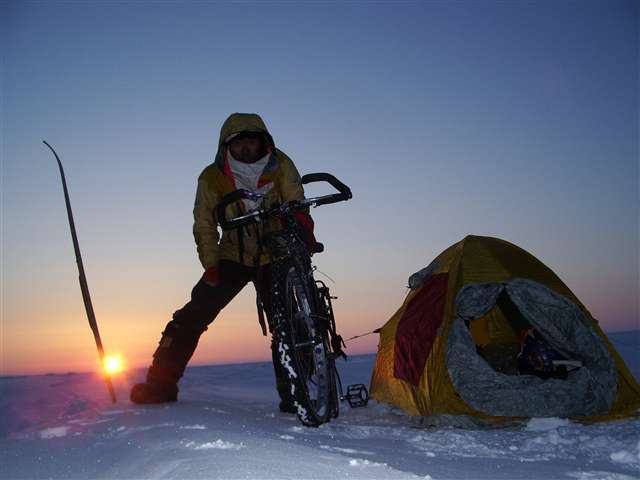
Camping on Arctic Ocean_R.jpg
@
@
@
ITINERARY from Sakhalin to Bering Sea on Chukot
@
AD2004-2005
Dec.18 2004:
Move from Japanfs Hokkaido to Russiafs Sakhalin by ship.
Dec.21:
Start from Yuzhino-Sakhalinsk by bicycle to across Sakhalin island.
Mid-Jan. 2005:
Cross the frozen Mamiya Strait from Sakhalin to the continent over two days.
Mid-Feb.:
Give up the shore line route of Okhotsk Sea. Take a train to the Sakha Republic.
Late-Feb.:
Oymyakon, the Poles of Cold. The temperature fell to minus 50 degrees Celsius.
Early-Mar.:
Cross over the mountain range of Oymyakon then go northward on frozen Kolyma
river.
Late-Mar.:
Enter the Arctic Circle. Pass Srednekolymsk.
Mid-Apr.:
Arrive at Cherskiy near the Arctic Ocean.
Early-May.:
Cross over the inland of the Chukot peninsula.
May.15:
Arrive at Egvekinot by the Bering Sea. End of my journey to the east.
May.18:
Move to Khabarovsk by air via Moscow. Pedal along remaining section of my route
from Khabarovsk to Sakha for 2,000-km.
Jun.10:
Arrive at Yakutsk – Completed my journey which chalking up 8,600-km on my
odometer from Sakhalin to the Bering Sea.
First, I planned to go northward along the Sea of Okhotsk from Sakhalin.
However, there was no winter road so I had to change my route to the inland
official road. I later cycled this section in June after having arrived at a
goal of the Bering Sea.
Across-Siberia touring has finished which from Murmansk to Magadan and Sakhalin
to Bering Sea. Total distance was altogether 24,500-km.
@

@
@
Japan Alpine News 2005
Ryqy{yz Bu|yuty
@
@
@
@
First Touring report
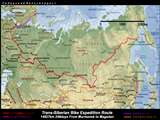
A Bicycle Odyssey across Winter Siberia
From
Murmansk @ 2002-2003 Winter
 Journey
across Siberia
Journey
across Siberia
@@
@
![]()
@
@
![]()
@
@
![]()
Special Thanks to
@
Outdoor Gear Equipment
![]()
![]()
![]()
![]()
![]()
![]()